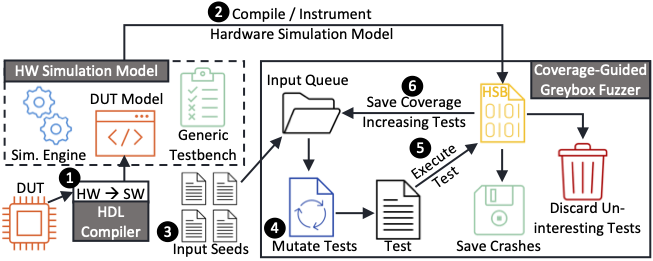Maintainer: Timothy Trippel
Personal Website: https://timothytrippel.com

Figure 1: Fuzzing Hardware Like Software.
Due to the economic and reputational incentives to design and fabricate flawless hardware, design verification research has been an active arena. Unfortunately the fruits of this labor mainly consist of strategies concentrated at two extremes: 1) broad coverage through constrained random verification, or 2) (bounded) formal verification. Moreover, both of these techniques require extensive implementation knowledge of the Design Under Test (DUT) to be effective.
To close this gap, we propose fuzzing hardware like software to automate test vector generation in an intelligent manner---that boosts coverage---without requiring expensive Design Verification (DV) engineers and tools. A technical paper describing this project can be found here.
In this project, we demonstrate how to translate RTL hardware to a software model, and leverage coverage-guided software fuzzers---like AFL---to automate test vector generation for hardware verification (Figure 1). Specifically we demonstrate this technique on hardware from the OpenTitan IP ecosystem. While we do not suggest this as a replacement to traditional DV methods for sign-off, we argue this technique serves a low-cost preventative mechanism to identify complex hardware vulnerabilities before they are exploited for malice.
To understand the layout of this project and how to get started, read below.
This directory currently only contains a document that describes how to contribute to this project and some figures that are displayed in this README. However, it will be the location of any future documentation that is added.
This directory contains some python scripts to automate launching large batches of fuzzing experiments on GCP VMs. Additionally there are some scripts that can be used to plot fuzzing data using Seaborn/Matplotlib.
This directory contains several supporting files to fuzz various various OpenTitan hardware IP blocks. Currently, the following OpenTitan IP blocks are supported: AES, HMAC, KMAC, and the RV Timer. Additionally, a subdirectory called ot_template can be copied, and the files within edited, to bring-up another OpenTitan IP block for fuzzing. Lastly, a custom digital lock hardware block is included to stress test our fuzzing infrastructure. This block is actually autogenerated by a tool written in Rust (using the kaze crate). For more details checkout the technical paper linked above.
This directory contains several subdirectories that contain Dockerfiles and Shell/Python scripts that makeup a containerized infrastructure for fuzzing hardware designs at scale. This infrastructure is modeled after Google's OSS-Fuzz project. This infrastructure can be used to jumpstart fuzzing hardware locally or on GCP (provided you have an active account). See Getting Started below for how to build this infrastructure. Read the technical paper above for exactly what is included in the fuzzing infrastructure.
This directory contains some HJSON fuzzing configuration files along with a Python script to test the overall fuzzing infrastructure is successfully simulating OpenTitan hardware.
git clone https://github.com/googleinterns/hw-fuzzing.gitcd hw-fuzzing
To use any of the fuzzing infrastructure, which consists of: 1) building several Docker images to isolate fuzzing each target hardware IP block, and 2) using two (included) Python packages, some environment variables must be set. You can set them system wide, however, I recommend using the direnv tool to set/unset them when you enter/leave your hw-fuzzing project directory.
- Create a
.envrcfile in the hw-fuzzing root directory with the following:
export HW_FUZZING=$(pwd)
export PYTHONPATH="./:../:$(pwd)/infra/hwfp:$(pwd)/infra/base-sim/hwfutils"
direnv allow
Add the above two lines to your .bashrc or .zshrc (depending on the shell you use), except replace the $(pwd) within each statement with the global path to your hw-fuzzing directory.
The automated Hardware Fuzzing Pipeline (HWFP) Python tooling is tested using Python 3.8, and requires the following dependencies.
- Create Python virtual environment (not required, but recommended).
- Activate virtual environment (if you made one).
pip install -r infra/hwfp/requirements.txtpip install -r infra/base-sim/hwfutils/requirements.txt
IV. Install Docker
make build-infra- Grab a cup of coffee ☕... this will take a while since we are building LLVM here.
make fuzz-<core>where<core>is [aes, hmac, kmac, rv_timer] to launch interactive container.runto begin RTL translation, intrustmentation, and fuzzing (if in manual mode, which is default, otherwise this step can be skipped).- Press
Ctrl+cto terminate fuzzing and begin final coverage tracing.
- Create GCP account.
- Create a GCS bucket to store all fuzzing data.
- Edit the gcp_config.hjson file with your GCP project details.
- Edit the value for the run_on_gcp key in the cpp_afl.hjson
configuration file for the core you want to fuzz in hw/
<core>/. - Run
make fuzz-<core>